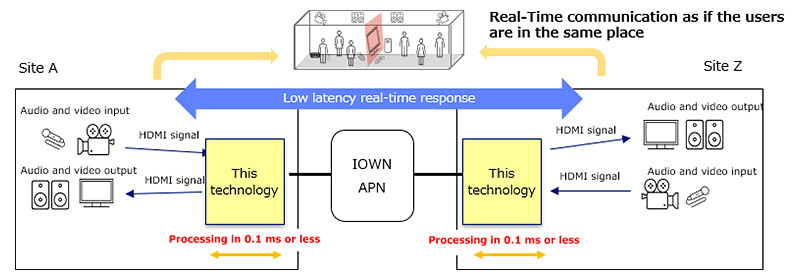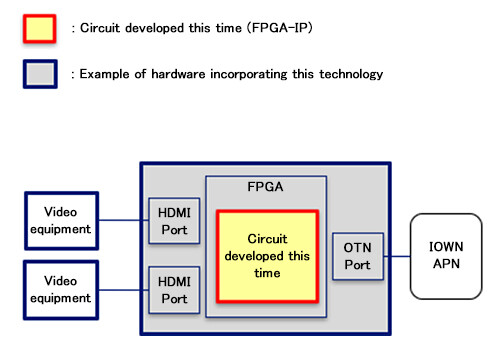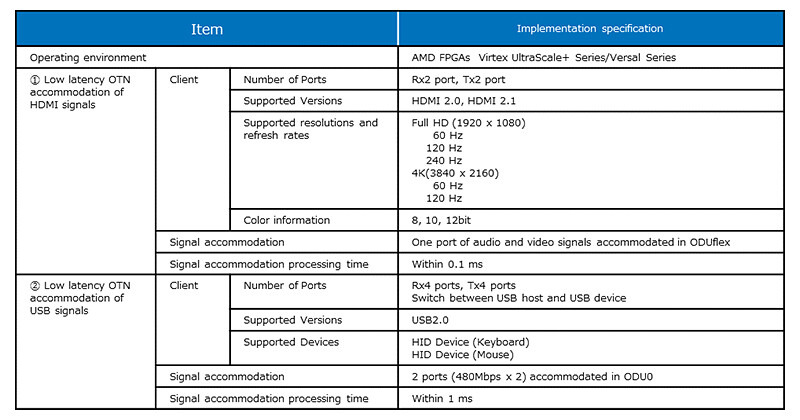Microsoft ends support for Internet Explorer on June 16, 2022.
We recommend using one of the browsers listed below.
- Microsoft Edge(Latest version)
- Mozilla Firefox(Latest version)
- Google Chrome(Latest version)
- Apple Safari(Latest version)
Please contact your browser provider for download and installation instructions.
October 8, 2024
NTT Corporation
Development of technology to convert HDMI signals into long-distance transmission signals with the world's lowest delay of 0.1 milliseconds or less
Realizing real-time communication where people feel like they are in the same place even if they are distant
TOKYO - October 8, 2024 - NTT Corporation (Headquarters: Chiyoda Ward, Tokyo; Representative Member of the Board and President: Akira Shimada; hereinafter "NTT") has developed a technology to convert 4K120Hz and FHD240Hz HDMI signals into long-distance transmission signals with the world's lowest delay of 0.1 ms or less. By combining this technology with the IOWN All-Photonics Network (APN)1, video transmission with both low delay and high definition is possible, and instantaneous motion and sound (up to 4K video displaying 120 frames per second) can be transmitted in real-time between remote locations.
Since this technology is implemented using the circuit information (FPGA-IP) available on the FPGA2, it is possible to combine various hardware depending on the use case such as the number of ports and size. This FPGA-IP is available for license (technical disclosure) for final products and solutions.
Background
The development of VR and AR technologies is expected to expand highly immersive applications that can provide realistic experiences in real-time communication, such as allowing many people to share the same "space" simultaneously and to collaborate from distant locations. To achieve a sense of immersion, it is necessary to experience images at multiple points simultaneously in real-time and to feel as if the users are seeing the real thing in high-definition video. For this reason, even when transmitting HDMI signals from video equipment (camera, monitor, etc.) widely used in offices and homes to distant locations, it is necessary to maintain low delay, high image quality, and high sound quality. However, conventional technologies based on the use of IP networks have been unable to achieve the real-time and high-definition required for highly immersive applications because of delays caused by signal compression due to network delay and network bandwidth shortage, and degradation of image and sound quality caused by signal compression (Figure 1).
 Figure 1 Challenges of Conventional Technology in Activities Requiring Real-Time Capabilities
Figure 1 Challenges of Conventional Technology in Activities Requiring Real-Time Capabilities
Details of the technology
NTT has developed a technology that converts uncompressed 4K120Hz and FHD240Hz HDMI signals into long-distance transmission signals with the world's lowest delay of 0.1 ms or less. By combining this technology with IOWN APN, it is possible to reproduce high-definition and ultra-fast-moving images at remote locations without degradation, and we can expect to realize real-time communication as if the users share the same place even in geographically separated environments (Figure 2).
 Figure 2 Video Transmission Using this Technology and IOWN APN
Figure 2 Video Transmission Using this Technology and IOWN APN
This technology accommodates video signals (HDMI signals) including audio directly into large-capacity, fixed-bandwidth, fixed-delay layer 1 signals (OTN3 signals), eliminating the processing time required to compress and decompress video signals and making it possible to transmit video to remote locations without video quality degradation or delay fluctuations due to communication. As a result, when the fiber propagation delay time4 is negligibly small, the delay time from video input at the transmitting side to video output at the receiving side is kept to 0.1 ms or less. In addition, by transmitting 4K120Hz and FHD240Hz high-resolution and high refresh rate video signals without compression, even ultra-fast-moving video can be transmitted to distant locations with high resolution and no degradation in motion.
This technology is implemented as circuit information (FPGA-IP) that can be used on an FPGA and can be combined with various types of hardware depending on the number of ports and sizes used (Figure 3). The specifications of the FPGA-IP developed by NTT are shown in Table 1.
 Figure 3 Image of the Newly Developed Circuit (FPGA-IP) and Hardware
Figure 3 Image of the Newly Developed Circuit (FPGA-IP) and Hardware
 Table 1 Specifications of the Newly Developed Circuit (FPGA-IP)
Table 1 Specifications of the Newly Developed Circuit (FPGA-IP)
Outlook
The combination of this technology and IOWN APN makes it possible to realize highly immersive applications (VR/AR), and remote activities (remote orchestral ensemble, remote chorus, dance lessons, etc.,) where real-time communication between locations is important, and remote interactions between people (debate, comedy, etc.,) with lower and more stable delay environments than ever before. In addition, since it is possible to deliver high-definition video to remote locations with low delay, it can be expected to be applied to areas where remote monitoring using real-time high-definition video was previously difficult such as monitoring plant lines, railways and traffic, etc. In the future, we will consider expanding the use cases that require both low delay and high-definition video and promote the realization of an affluent society.
This FPGA-IP is available for license (for a fee). This technology is realized by the circuit information (FPGA-IP) available on the FPGA and can be combined with various hardware.
[Glossary]
1.IOWN APN (All-Photonics Network)
IOWN consists of three components: the All-Photonics Network (APN), which introduces photonics (optics) based technology to every aspect from the network to devices; Digital Twin Computing, which enables advanced real-time interaction between objects and people in cyberspace; and the Cognitive Foundation, which efficiently deploys various ICT resources including these.
By introducing new optical technologies into the network, devices, and chips, APN achieves ultra-low power consumption and ultra-high-speed processing, which were previously difficult to achieve. By allocating wavelengths for each function on a single optical fiber, it is possible to provide multiple functions that support social infrastructure, such as information communication functions such as the Internet and sensing functions, without interfering with each other.
https://www.rd.ntt/e/iown/
2.FPGA (Field Programmable Gate Array) is an integrated circuit capable of rewriting logic, combining the flexibility of software and the high speed of hardware.
3.Optical Transport Network (OTN) is a communication standard defined by The International Telecommunication Union Telecommunication Standardization Sector (ITU-T).
4.The physical time it takes to transmit a signal over an optical fiber. (5μs/km)
About NTT
NTT contributes to a sustainable society through the power of innovation. We are a leading global technology company providing services to consumers and businesses as a mobile operator, infrastructure, networks, applications, and consulting provider. Our offerings include digital business consulting, managed application services, workplace and cloud solutions, data center and edge computing, all supported by our deep global industry expertise. We are over $97B in revenue and 330,000 employees, with $3.6B in annual R&D investments. Our operations span across 80+ countries and regions, allowing us to serve clients in over 190 of them. We serve over 75% of Fortune Global 100 companies, thousands of other enterprise and government clients and millions of consumers.
Media contact
NTT IOWN Integrated Innovation Center
Public Relations
nttrd-pr@ml.ntt.com
Information is current as of the date of issue of the individual press release.
Please be advised that information may be outdated after that point.
NTT STORY
WEB media that thinks about the future with NTT










